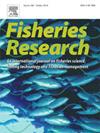Marine fishing fleet in the Soviet Union: A review of its structure and dynamics
IF 2.3
2区 农林科学
Q2 FISHERIES
引用次数: 0
Abstract
The Soviet Union was a prominent player in the marine living resource sector for a long time, owing to its powerful fishing fleet. In this paper, we summarized information on the fleet structure and analyzed its long-term dynamics during the postwar period (1946–1991). In terms of vessel type and project diversity, trawlers were the leading category, followed by transport vessels (carriers and reefers), processing vessels, and seiners. These categories also represented the largest share of the total fleet in terms of their relative contributions. The fleet modernization resulted in vessel types with greater length, speed, engine power, and processing capabilities. The number of vessels (NV) and total gross tonnage (TGT) increased in all categories except for whalers and sealers. The most pronounced increase in NV and TGT occurred from the mid-1950s to the mid-1970s. Medium-sized trawlers were the dominant category in terms of NV until 1978, while large-sized trawlers were the most common from 1979 to 1991. The observed positive changes in fleet structure reflected broader trends, including the modernization of the fishing sector, the reallocation of fishing efforts to high seas, and the impact of marine organism stock fluctuations. These changes aligned closely with global patterns in the industry. However, negative trends began to manifest in the 1980s, linked to inadequate management practices and challenges in advancing fleet modernization. Our study introduces novel insights for comparative analyses and retrospective studies on stock fluctuations in relation to fleet dynamics.
苏联海洋渔船队的结构与动态
由于拥有强大的捕鱼船队,苏联长期以来一直是海洋生物资源领域的重要参与者。本文总结了战后(1946-1991)舰队结构的相关信息,并对其长期动态进行了分析。就船型和项目多样性而言,拖网渔船是主要类别,其次是运输船(运输船和冷藏船)、加工船和围网船。就其相对贡献而言,这些类别也占整个船队的最大份额。舰队现代化导致了更长的船舶类型,速度,发动机功率和处理能力。除捕鲸船和海豹捕鲸船外,所有类别的船舶数量和总吨位均有所增加。NV和TGT最显著的增长发生在20世纪50年代中期到70年代中期。中型拖网渔船在1978年以前的净捕捞量占主导地位,而大型拖网渔船在1979年至1991年期间最常见。观察到的船队结构的积极变化反映了更广泛的趋势,包括渔业部门的现代化、将捕鱼努力重新分配到公海以及海洋生物种群波动的影响。这些变化与行业的全球模式密切相关。然而,消极趋势在1980年代开始显现,这与管理做法不足和推进船队现代化方面的挑战有关。我们的研究为与船队动力学相关的库存波动的比较分析和回顾性研究引入了新的见解。
本文章由计算机程序翻译,如有差异,请以英文原文为准。
求助全文
约1分钟内获得全文
求助全文
来源期刊

Fisheries Research
农林科学-渔业
CiteScore
4.50
自引率
16.70%
发文量
294
审稿时长
15 weeks
期刊介绍:
This journal provides an international forum for the publication of papers in the areas of fisheries science, fishing technology, fisheries management and relevant socio-economics. The scope covers fisheries in salt, brackish and freshwater systems, and all aspects of associated ecology, environmental aspects of fisheries, and economics. Both theoretical and practical papers are acceptable, including laboratory and field experimental studies relevant to fisheries. Papers on the conservation of exploitable living resources are welcome. Review and Viewpoint articles are also published. As the specified areas inevitably impinge on and interrelate with each other, the approach of the journal is multidisciplinary, and authors are encouraged to emphasise the relevance of their own work to that of other disciplines. The journal is intended for fisheries scientists, biological oceanographers, gear technologists, economists, managers, administrators, policy makers and legislators.
 求助内容:
求助内容: 应助结果提醒方式:
应助结果提醒方式:


